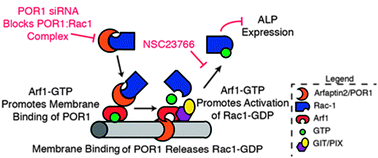Geometry sensing through POR1 regulates Rac1 activity controlling early osteoblast differentiation in response to nanofiber diameter
Abstract
Bone grafting procedures in the United States rely heavily upon autografts and allografts, which are donor-dependent, cause donor site pain, and can transmit disease. Synthetic bone grafts can reduce these risks; however, synthetics lack the bone differentiating (osteoinductive) abilities of auto- and allografts. Achieving innate osteoinductive properties of synthetics through surface modifications is currently under investigation. This study focuses on nanofibers, with emphasis on how fiber diameter and the potential curvature sensor POR1 affect the activation of the signaling molecules Rac1 and Arf1, and leading to expression of alkaline phosphatase (ALP), an osteoinductive marker. Diameters of 0.1, 0.3, and 1.0 μm were compared against a flat control. The highest level of Rac1 activation was achieved on the smallest fibers (0.1 μm), a trend that was lost in POR1 knockdowns. This supports the hypothesis that on small nanofibers, POR1 favorably binds to highly curved cell membranes, which allows Rac1 to subsequently dissociate and activate. When the curvature is insufficient to bind POR1, POR1 binds to inactive Rac1 and competitively inhibits its activation. Arf1 activation followed an opposite trend, with the largest nanofibers exhibiting the highest activity. This trend reinforces the known interaction between Rac1 and Arf1 through the GIT–PIX complex, an Arf1 GAP and Rac1 GEF, respectively. Large, (1.0 μm), nanofibers demonstrated the highest ALP activity, indicating that ALP expression is inversely dependent on Rac1 activation. Knockdown of POR1 resulted in increased ALP activity across the substrates but without regard to the curvature sensing trend seen previously. Thus, POR1 senses curvature and increases Rac1 activity, which negatively regulates bone differentiation.


 Please wait while we load your content...
Please wait while we load your content...